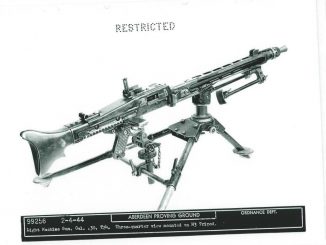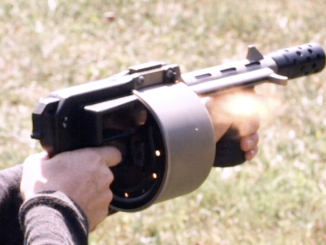The Johnson LMG was adopted by the US Marine Corps for specialist units like Paramarines and Raiders, and saw use in some of the fiercest island campaign of the Pacific (in addition to use in Europe by the 1st Special Service Force and others). It was a light and hard-hitting weapon that was well-liked by the men who used it. I’ve been wanting to try one for a while, and this was a great opportunity to do so.
While the Johnson is light and handy compared to similar arms like the BAR, it has substantially more muzzle blast, climb, and felt recoil than other designs that use the same .30-06 cartridge.




Awesome.
Is it the long recoil action w/ so much reciprocating mass moving about that’s causing the significant felt recoil? It’s odd that the M-14 has less reciprocating mass than the Garand, but in .308, the felt recoil of the Garand is noticeably less than the M-14, likely b/c of the lower pressure at the gas port of the Garand.
The increased recoil and blast of the Johnson’s (both rifles and LMG’s) come mostly from their recoil operation and shorter barrels, right? The Garand gas system and longer barrel soften the 30-06 a bit. Reciprocating mass and springs might be a factor also?
Observe that Johnson M1941 https://modernfirearms.net/en/machineguns/u-s-a-machineguns/johnson-m1941-m1944-eng/ is significantly lighter than M1918A2 http://modernfirearms.net/en/machineguns/u-s-a-machineguns/browning-m1918-bar-eng/ weighting 6.48 kg versus 8.8 kg
The muzzle flash must be shocking. Can you add some video of this doing night fire?
Ian,
How does this compare to shooting the FG42? Would the Johnson LMG work in the same role as the FG42?
Brent
Reload the mag with stripper clips? Shades of the VZ58!
Except that the VZ58 requires the bolt to be locked back. Whereas the Johnson allow to do it with the bolt ready to fire in both semi and full.
And not only you can top it off, you can also add 5 extra rounds over the 20 rounds in the magazine.
I grew up in the belief that the Johnson weapons could be converted to 7 x 57 mm by a barrel change. This was the tale told in the 2nd edition of Phil Sharpe’s “The Rifle in America.” I can’t nowadays find any such notion in the literature, but wouldn’t a 7 mm Johnson be a dandy gun? Or chambered in, say, 6.5 mm Swedish?
“(…)could be converted to 7 x 57 mm by a barrel change.(…)
Whilst I do not know if conversion would be such easy, my search revealed that Johnson 1941 rifles chambered for that caliber did exist, they seems to be known as Chilean Contract by U.S. collectors
Examples:
https://investmentsinarms.com/product/johnson-1941-chilean-contract-military-rifle-7mm-b1483-a-1662/
https://www.rockislandauction.com/detail/85/1358/chilean-contract-johnson-1941-semiautomatic-rifle-in-7mm-mauser
Chile and Venezuela both used 7mm Mauser-caliber Johnson self-loading rifles.